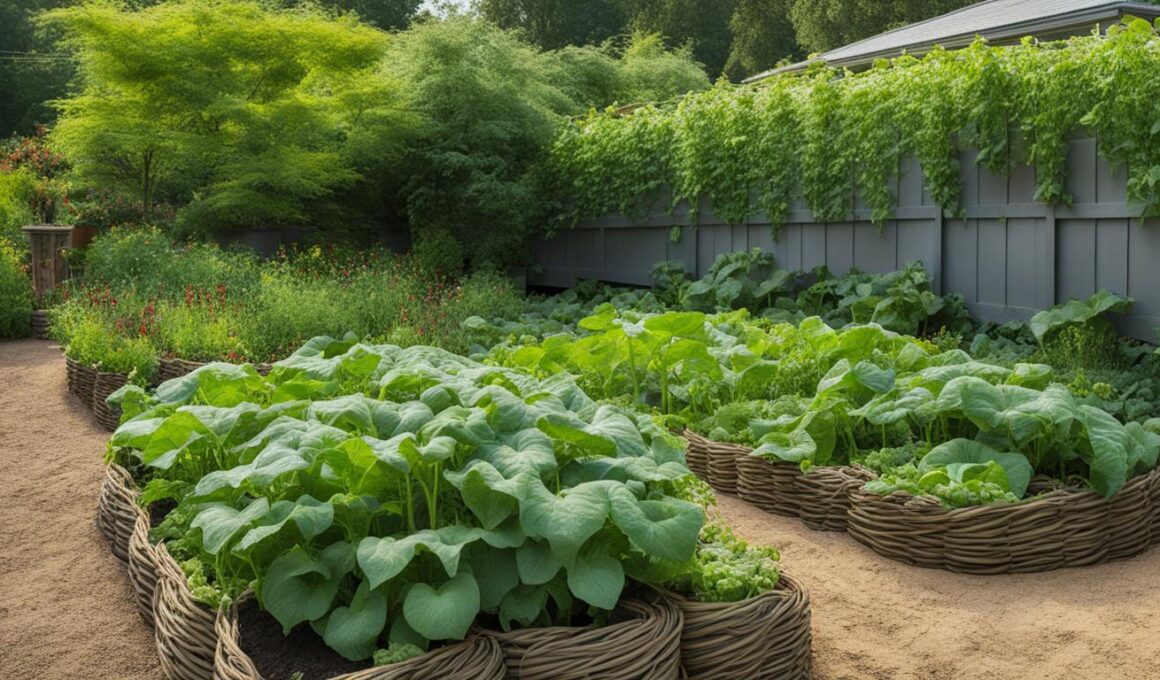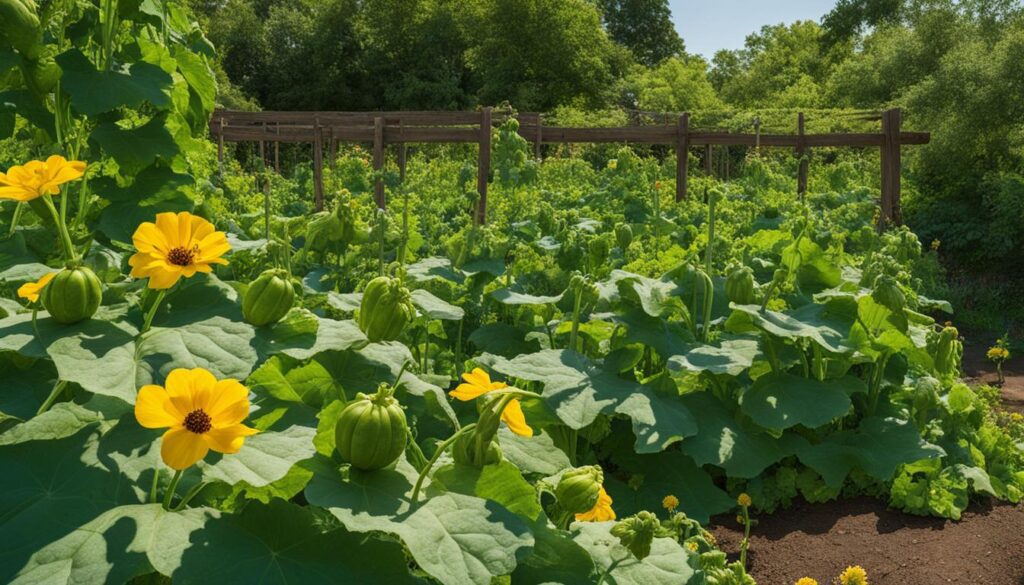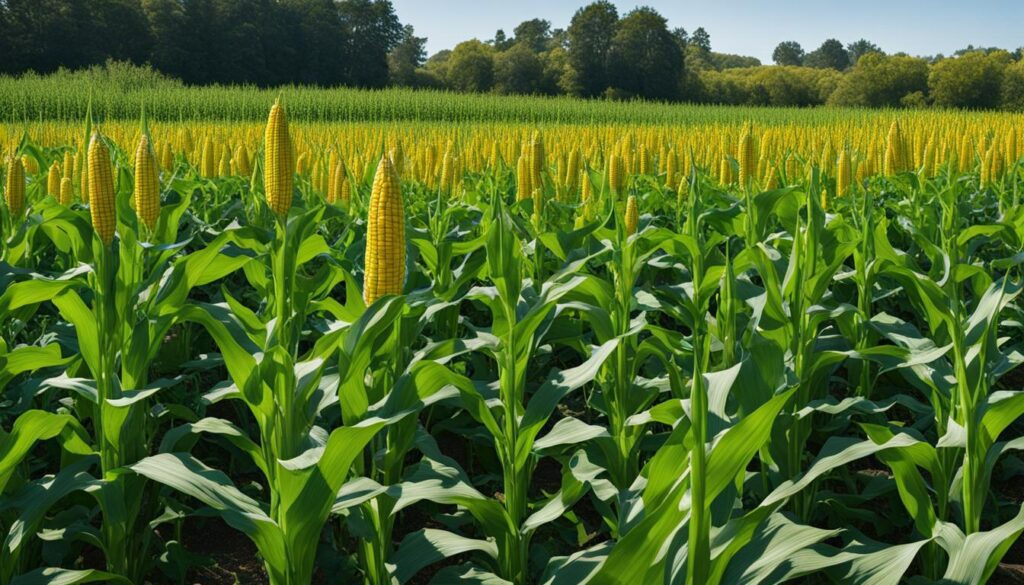Companion planting is an ancient gardening technique where certain plants are grown together to enhance growth and productivity. One classic example of companion planting is the three sisters garden, which involves growing corn, beans, and squash together. This method was practiced by Native American tribes and offers numerous benefits such as improved soil fertility, weed suppression, and increased yields. By understanding the principles and steps of growing squash and beans together, you can create your own thriving three sisters garden.
Post Summary:
- Growing squash and beans together in a three sisters garden is an ancient gardening technique.
- The three sisters garden involves planting corn, beans, and squash together.
- Companion planting provides benefits like improved soil fertility and weed suppression.
- By following the steps and principles of companion planting, you can create a successful three sisters garden.
- The three sisters garden has cultural significance, representing sustainable food production and ancestral knowledge.
The Benefits of the Three Sisters Garden
When it comes to companion planting, the three sisters garden offers a host of benefits. The corn, beans, and squash plants work together in a symbiotic relationship, creating a harmonious and productive garden ecosystem. The cornstalks provide a natural trellis for the climbing beans, while the beans fix nitrogen in the soil, benefiting both the corn and squash. The large leaves of the squash plants shade the ground, preventing weed growth and helping to retain soil moisture. This combination of plants not only improves soil fertility but also reduces the need for synthetic fertilizers, contributing to sustainable gardening practices.
By growing squash and beans together in a three sisters garden, you can create an efficient and self-sustaining system. The symbiotic relationship between these plants enhances their individual growth and productivity, resulting in healthier and more abundant harvests. Additionally, the shade provided by the squash plants acts as a natural weed suppressant, minimizing the need for manual weeding and chemical herbicides. This not only saves time and effort but also promotes a healthier and more environmentally friendly garden environment.
“The three sisters garden is a wonderful example of nature’s wisdom and the power of companion planting. By harnessing the benefits of this symbiotic relationship, you can achieve a more bountiful and sustainable harvest in your own backyard.”
Another advantage of the three sisters garden is its ability to improve soil fertility. The combination of corn, beans, and squash plants works together to create a balanced and nutrient-rich soil ecosystem. The beans fix nitrogen from the air into the soil, providing a natural source of fertilizer for all three plants. This reduces the need for synthetic fertilizers and promotes a more organic and sustainable approach to gardening. The interplay between these plants not only benefits their growth but also enhances the overall health and vitality of the soil, leading to better long-term gardening success.
| Benefits of the Three Sisters Garden |
|---|
| Enhances soil fertility through nitrogen fixation |
| Reduces the need for synthetic fertilizers |
| Suppresses weeds naturally |
| Conserves soil moisture |
| Promotes sustainable and eco-friendly gardening practices |
Choosing the Right Varieties for a Three Sisters Garden
When it comes to creating a successful three sisters garden, selecting the right varieties of corn, beans, and squash is crucial. Each plant has its unique requirements and characteristics that contribute to the symbiotic relationship in the garden. Here are some tips on choosing suitable varieties for a thriving three sisters garden:
Corn Varieties:
For the corn component of your garden, opt for tall varieties that reach at least six feet in height. Tall cornstalks provide sturdy support for the climbing beans and create a trellis-like structure for them to grow on. Some popular corn varieties for three sisters gardens include ‘Hopi Blue’ and ‘Floriani Red Flint’.
Bean Varieties:
When it comes to beans, pole bean varieties work best in a three sisters garden as they have the climbing ability to utilize the cornstalks as a natural trellis. Look for pole bean varieties like ‘Kentucky Wonder’ or ‘Scarlet Runner’ that will thrive in the companionship of corn and provide nitrogen fixation to enrich the soil.
Squash Varieties:
For the squash component of the three sisters garden, it’s important to choose winter squash varieties that spread across the ground. Winter squash varieties like ‘Butternut’, ‘Acorn’, or ‘Delicata’ are ideal choices as they have trailing vines that cover the soil and inhibit weed growth. Avoid planting summer squash varieties in a three sisters garden as they tend to grow in clumps and don’t provide the same groundcover benefits as winter squash.
By carefully selecting the right varieties for your three sisters garden, you can ensure a harmonious and productive garden bed where each plant thrives in symbiosis with the others.
| Crop | Varieties |
|---|---|
| Corn | ‘Hopi Blue’, ‘Floriani Red Flint’ |
| Beans | ‘Kentucky Wonder’, ‘Scarlet Runner’ |
| Squash | ‘Butternut’, ‘Acorn’, ‘Delicata’ |
Planting a Three Sisters Garden
When it comes to planting a three sisters garden, there are several key steps to follow. First, you’ll want to start by building a circular mound of soil that’s approximately 5 feet in diameter. This mound will serve as the foundation for your garden and provide the necessary space for all three crops to thrive.
Once you’ve built the mound, it’s important to mix in compost and soil amendments to ensure proper fertility and nutrient levels. This will help support the growth and development of your squash, beans, and corn throughout the growing season.
Next, you’ll want to begin planting the crops in a specific spatial configuration. Start by planting the corn seeds first, spacing them in a circle on top of the mound. Be sure to follow the recommended spacing guidelines for your chosen variety of corn.
After the corn has reached a height of approximately 6 to 8 inches, it’s time to plant the bean seeds. Place these seeds inside the circle of corn, allowing them to grow and climb up the cornstalks for support. This symbiotic relationship between the corn and beans is a key aspect of the three sisters garden.
Finally, plant the squash seeds outside the circle of corn. The large, spreading leaves of the squash plants will provide shade for the soil, suppressing weed growth and retaining moisture. Choose varieties of squash that are well-suited for spreading across the ground, such as butternut or acorn squash.
| Plant | Spacing |
|---|---|
| Corn | 12-15 inches apart |
| Beans | 3-4 inches apart |
| Squash | 2-3 feet apart |
Remember to water your three sisters garden regularly and provide any necessary support for the climbing bean vines. As the crops grow, be sure to monitor and control any weeds that may appear, as they can compete with your plants for resources.
By following these steps and maintaining proper care throughout the growing season, you can enjoy a successful and bountiful three sisters garden with flourishing squash, beans, and corn.
The Tradition and Significance of the Three Sisters
The three sisters garden holds a special place in Native American agricultural traditions, reflecting a rich cultural heritage and sustainable food production practices. For Native American tribes like the Haudenosaunee, the three sisters—corn, beans, and squash—represent more than just crops; they are seen as gifts from the gods, meant to be grown and consumed together. This traditional planting method not only provided a balanced diet but also offered sustainable food sources that could be stored for year-round availability.
The three sisters garden embodies the interconnectedness of nature and the importance of collaboration. The cornstalks provide the structural support for the climbing beans, while the beans return the favor by fixing nitrogen in the soil, benefiting both the corn and squash. Additionally, the large leaves of the squash plants shade the ground, preventing weed growth and preserving soil moisture. This symbiotic relationship between the three plants creates a harmonious and sustainable ecosystem within the garden.
“In the three sisters garden, we honor our ancestors and the wisdom they passed down to us. It’s a celebration of sustainable practices and a reminder of our deep connection to the land.”
The cultural significance of the three sisters garden extends beyond its practical benefits. It serves as a symbol of unity, community, and reverence for the Earth. By following this traditional planting technique, we not only practice sustainable agriculture but also honor the wisdom and knowledge of those who came before us. The three sisters garden is a testament to our shared heritage and a reminder of the importance of sustainable food production for future generations.
Significance of the Three Sisters in Native American Tribes
| Tribe | Three Sisters Symbolism |
|---|---|
| Haudenosaunee (Iroquois) | The three sisters are considered the sustainers of life and represent the interdependence of the people, the land, and all living things. |
| Hopi | The three sisters are associated with creation and fertility. They symbolize the balance and harmony between humans and nature. |
| Cherokee | The three sisters represent the three stages of womanhood: the corn represents the maiden, the beans symbolize the mother, and the squash embodies the elder. |
By embracing the tradition and significance of the three sisters garden, we continue to cultivate sustainable food systems and preserve the knowledge passed down through generations. Whether you’re a seasoned gardener or just starting out, incorporating the three sisters into your garden not only yields bountiful harvests but also pays homage to the ancient wisdom of Native American agricultural practices.
Conclusion
Growing vegetables together in a three sisters garden using the companion planting technique can lead to a successful and bountiful harvest. By harnessing the benefits of this ancient gardening practice, you can create a thriving ecosystem where plants support and enhance each other’s growth.
Companion planting, such as growing squash and beans together, promotes improved soil fertility, as the corn, beans, and squash work together in a symbiotic relationship. The cornstalks provide a sturdy trellis for the beans to climb, while the beans fix nitrogen in the soil, benefiting both the corn and squash. The large leaves of the squash plants shade the ground, preventing weed growth and retaining soil moisture.
When planning your three sisters garden, selecting the right varieties and following the planting steps will set you up for success. Choose tall corn varieties that can support the climbing beans, opt for pole beans instead of bush beans, and select winter squash varieties that spread across the ground. By sowing the seeds in a specific spatial configuration and providing proper care, you can create an environment where each plant thrives and contributes to a bountiful harvest.
Remember, growing squash and beans together in a three sisters garden is not just a gardening technique. It is a way to honor Native American agricultural traditions and embrace sustainable food production. So, dig in, enjoy the process, and reap the rewards of a flourishing garden that not only provides you with fresh produce but also celebrates the wisdom of our ancestors.
FAQ
What is companion planting?
Companion planting is an ancient gardening technique where certain plants are grown together to enhance growth and productivity.
What is a three sisters garden?
A three sisters garden is a companion planting method involving growing corn, beans, and squash together.
What are the benefits of a three sisters garden?
A three sisters garden improves soil fertility, suppresses weeds, and increases yields.
What varieties should I choose for a three sisters garden?
For corn, choose tall varieties. For beans, opt for pole beans. For squash, choose winter squash varieties.
How do I plant a three sisters garden?
Start by building a circular mound of soil and plant the corn first. Once the cornstalks are tall enough, plant the beans inside the circle of corn and the squash outside the circle.
What is the cultural significance of a three sisters garden?
The three sisters garden has deep roots in Native American agricultural traditions and represents a sustainable way of food production.
Can I grow squash and beans together in my own garden?
Yes, growing squash and beans together in a three sisters garden can be a rewarding and successful gardening experience.











